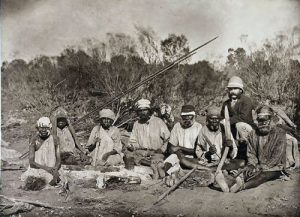In the Steps of Frederic Bonney
If you have read our online writing jobs web pages concerning “people of Note” who have lived in Colton you will find information about Frederic Bonney. He lived out in Australia between 1862 and 1880 and then came to live at Colton House. Whilst he was there he took many photos of the aborigines and the local settlers. His photos are now in National Collections in Australia. I went to Australia at the beginning of 2008 to Momba station where Bonney had lived to try and find what was left of the places he had photographed. Although many of the buildings had disappeared, I was able to find the ruins of some of them and also particular places he had photographed.
By pure chance an Australian archaeologist made contact with me just after I had returned because she was also researching Frederic Bonney and his life on Momba Station. She wanted to know all about his family connections to Colton and Rugeley. She visited Colton in July. Bev and Jill Croft and myself took her to all the places that had connections with the Bonney Family. She was even able to stay at Colton House because it is now a bed and breakfast!
They are an extremely interesting family. Frederic’s Uncle Charles is famous in Australia because he was one of the first “overlanders” opening up new routes to drive stock across country.
We are planning to write a book about the Bonney’s and would welcome any information anyone may have on them.
Gill Sykes
Frederic Bonney
 |
Frederic Bonney was the son of the head teacher of Rugeley grammar school. His Uncle, Charles Bonney was one of the celebrated early Australian explorers who had established overland tracks for the early pastoralists.
Frederic’s elder brother had also gone out to Australia to live and work as a manager of a 2 ½ million acre sheep station at Momba on the Darling river north of Adelaide. Photograph of Bonney with Aborigines Frederic decided to go and work out there with him and did so for a number of years. He had developed his hobby of photography and whilst he lived there he took some of the first pictures of Aborigines and made many anthropological notes. His work was recognised as a contribution to our understanding of life in Australia and he was made a Fellow of the Royal Geographical Society. He also took many pictures of the first settlers in and around the Murray River region north of Adelaide. |
